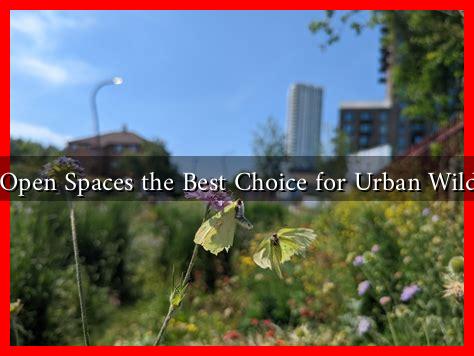-
Table of Contents
Are Open Spaces the Best Choice for Urban Wildlife?
As urbanization continues to expand, the need for sustainable environments that support wildlife has become increasingly critical. Open spaces, such as parks, gardens, and green roofs, are often touted as the best choice for urban wildlife. But are they truly the optimal solution? This article explores the benefits and challenges of open spaces for urban wildlife, supported by case studies and statistics.
The Importance of Urban Wildlife
Urban wildlife plays a crucial role in maintaining ecological balance. They contribute to biodiversity, pollination, and pest control, which are essential for healthy urban ecosystems. However, urban environments can be hostile to wildlife due to habitat loss, pollution, and human activity. This raises the question: can open spaces effectively mitigate these challenges?
Benefits of Open Spaces for Urban Wildlife
Open spaces offer several advantages for urban wildlife, including:
- Habitat Creation: Parks and gardens provide essential habitats for various species, from birds to insects. For instance, Central Park in New York City serves as a vital refuge for over 200 bird species.
- Food Sources: Open spaces often contain native plants that provide food for wildlife. A study by the National Wildlife Federation found that urban gardens can support a diverse range of pollinators.
- Corridors for Movement: Green spaces can act as corridors, allowing wildlife to move between fragmented habitats. This connectivity is crucial for species survival, particularly in urban areas.
- Community Engagement: Open spaces can foster community involvement in wildlife conservation, as seen in initiatives like the “Adopt-a-Park” programs that encourage local stewardship.
Challenges Faced by Urban Wildlife in Open Spaces
Despite their benefits, open spaces also present challenges for urban wildlife:
- Human Disturbance: High foot traffic and recreational activities can disrupt wildlife habitats. For example, the presence of dogs in parks can deter birds from nesting.
- Pollution: Urban areas often suffer from air and water pollution, which can negatively impact wildlife health. A study published in the journal Environmental Pollution highlighted how pollutants can affect the reproductive success of urban birds.
- Invasive Species: Open spaces can be susceptible to invasive plant and animal species that outcompete native wildlife. This can lead to a decline in biodiversity.
- Limited Resources: Not all open spaces are created equal. Some may lack the necessary resources, such as food and shelter, to support diverse wildlife populations.
Case Studies: Success Stories and Lessons Learned
Several cities have implemented successful strategies to enhance open spaces for urban wildlife:
- Chicago’s Green Roofs: Chicago has embraced green roofs as a way to create habitats for birds and insects. The city’s green roof initiative has led to increased biodiversity, with over 100 species of birds observed on these roofs.
- London’s Urban Wildlife Strategy: London has developed a comprehensive strategy to enhance urban wildlife through parks and green corridors. The strategy has resulted in a 20% increase in the number of species recorded in the city.
- Singapore’s Park Connector Network: Singapore has created a network of park connectors that link various green spaces, allowing wildlife to thrive. This initiative has been instrumental in supporting biodiversity in a densely populated city.
Conclusion: A Balanced Approach to Urban Wildlife
Open spaces undoubtedly play a vital role in supporting urban wildlife, offering habitats, food sources, and corridors for movement. However, they are not without challenges. To maximize their potential, cities must adopt a balanced approach that includes:
- Minimizing human disturbance through designated wildlife zones.
- Implementing pollution control measures to protect wildlife health.
- Managing invasive species to preserve native biodiversity.
- Enhancing the quality of open spaces to provide adequate resources for wildlife.
In conclusion, while open spaces are a crucial component of urban wildlife conservation, they must be thoughtfully designed and managed to truly benefit the diverse species that inhabit our cities. By fostering collaboration between urban planners, ecologists, and local communities, we can create urban environments that not only support wildlife but also enrich the lives of city dwellers.
For more information on urban wildlife conservation, visit the National Wildlife Federation.

